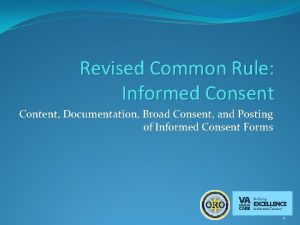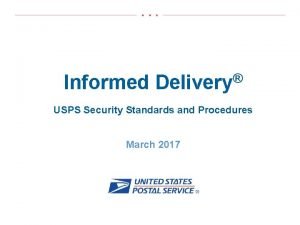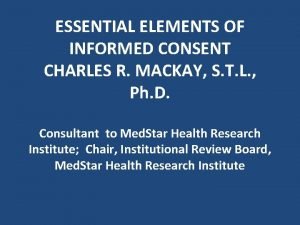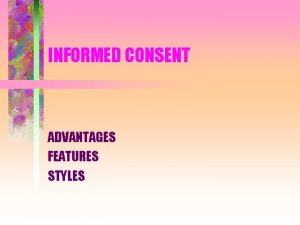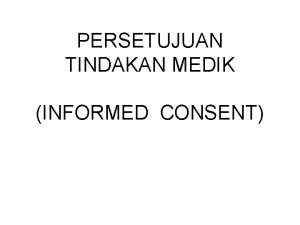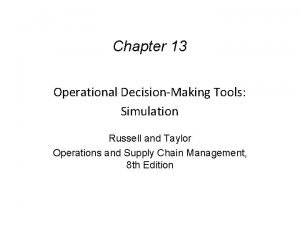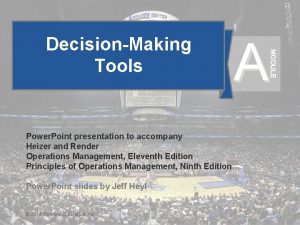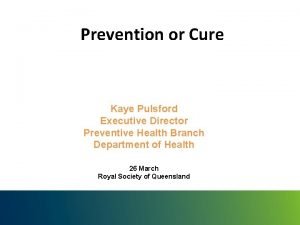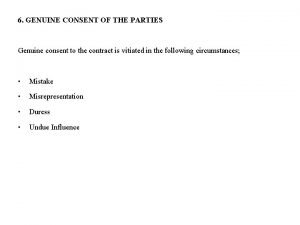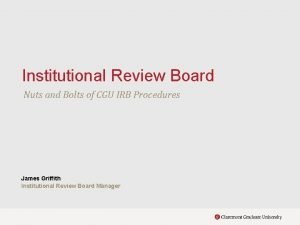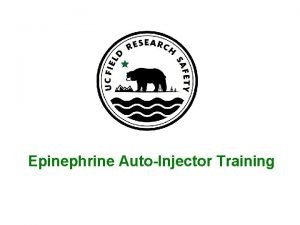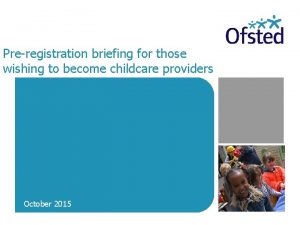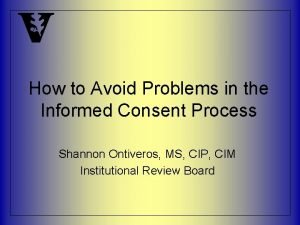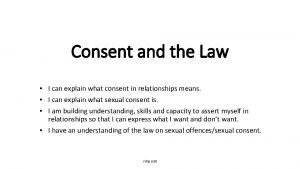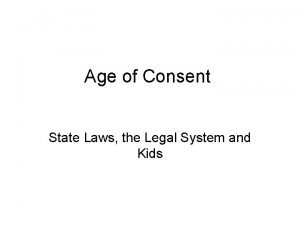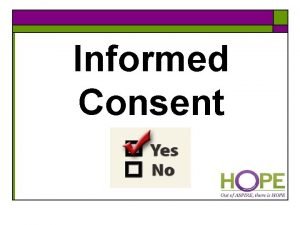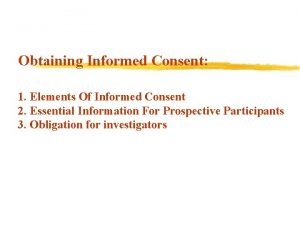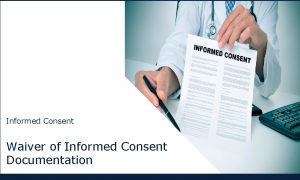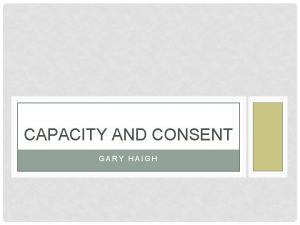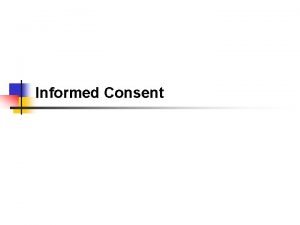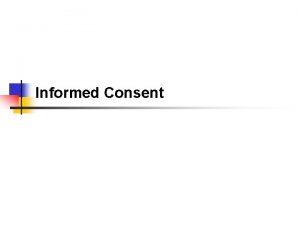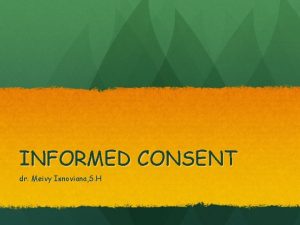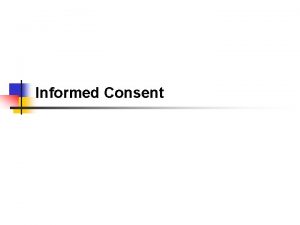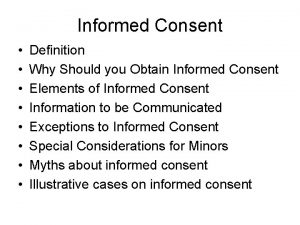Making Informed Consent an Informed Choice Tools from



































- Slides: 35

Making Informed Consent an Informed Choice: Tools from AHRQ Cindy Brach Center for Delivery, Organization, & Markets April 5, 2017

Disclosure I have no relevant financial interests

Overview • Problems with Informed Consent • Training Modules • Leaders Module • Health Care Professionals Module • Pilot Test Findings

Learning About You • Where do you work and in what capacity? • What do you hope to learn in the next hour?

Informed Consent: The Problem Patients • Misunderstanding ► • Benefits, harms, risks, alternatives Don’t know they can say no Clinicians • • • Just a form Don’t offer choices Malpractice top 10 5

To what extent do clinicians obtaining consent in your hospital/unit agree with the following statements? Chief purpose of IC is to comply with regulations Getting signature is most critical part of informed consent Refusing a life-saving procedure demonstrates patient is not capable of making a decision Clinicians are in a better position to make decisions than patients Staff attitudes (n=235) Clinicians should not present less effective alternatives Clinicians should encourage patients to talk about values Informed consent process is worth the time Lack of patient understanding of IC is safety problem Clinicians are responsible for ensuring that patients undertstand their options 0% 20% 40% 60% 80% 100% Percentage 'Agree' or 'Strongly Agree’ (%)

How frequently do clinicians do the following when obtaining informed consent? Use decision aids Teach-back to confirm understanding Leaders' perception of clinician IC practices (n=22) Informed Consent Practices Elicit Goals and Values Confirm consent before procedure Offer choices Staff's perception of clinicians' IC practices (n=235) Engage patients/family in discussion Neutral Explanation Clinicians' selfreport (n=45) Encourage Questions Call for Qualified Interpreters Assess decision-making capacity 0% 20% 40% 60% Percentage 'Usually' or 'Always' (%) 80% 100%

Why Two Modules? • Ingredients for successful quality improvement: Leadership support ► Prepared workforce ► • Leaders module – for C-suite and other execs • Health care professionals module – teach skills • to clinical teams Health literacy relevance: informed consent requires clear communication about choices Both modules are available to Joint Commission-accredited Institutions for free continuing medical education credit 8

9

Approach: Enduring and Interactive Modules • Video recordings • Provider illustrations • Knowledge checks • Illustrative scenarios • Patient friendly forms • Model conversation • Multiple resources • Patient stories

Making Informed Consent an Informed Choice: Training for Health Care Leaders Sponsored by: Agency for Healthcare Research and Quality (AHRQ) Contract No. HHSA 290201000031 I, Task Order #3 The development and production of this course was a joint effort by AHRQ, Abt Associates, and The Joint Commission. The authors of this module are responsible for its content. No statement may be construed as the official position of the Agency for Healthcare Research and Quality or the U. S. Department of Health and Human Services.

Leaders Module Components Three Components Principles of informed consent 2. Policy 3. Supportive Systems 1. • Worksheets throughout • 34 new and existing resources – e. g. , Championing Change, AHRQ Health Literacy Universal Precautions Toolkit. 12

Principles of Informed Consent • Clarify patients’ rights • Legal and patient safety implications • Patient capacity for decision making Toni Cordell 13

Policy • • Purpose Who can obtain IC When Content Documentation Exceptions Clear communications policy (plain language, using teach-back, accommodating communication needs) • • Compliance Enforcement Dissemination Review 14

Informed Consent Policy Worksheet 15

Picture of slide 42 Building Systems to Improve the Informed Consent Process 16




Making Informed Consent an Informed Choice: Training for Health Care Professionals Sponsored by: Agency for Healthcare Research and Quality (AHRQ) Contract No. HHSA 290201000031 I, Task Order #3 The development and production of this course was a joint effort by AHRQ, Abt Associates, and The Joint Commission. The authors of this module are responsible for its content. No statement may be construed as the official position of the Agency for Healthcare Research and Quality or the U. S. Department of Health and Human Services.

Health Care Professionals Module: 10 Strategies Clear Communication Presenting Choices 1. Prepare for the Informed 5. Offer Choices Consent Discussion 6. Engage Patients, 2. Use Health Literacy Families and Friends Universal Precautions 7. Elicit Goals and Values 3. Remove Language 8. Show High Quality Barriers 4. Use Teach-Back Decision Aids 9. Explain Benefits, Harms, and Risks of All Options 10. Help Patients Choose

The Teach-Back Process Chunk and teach information. Ask patients to teach back in their own words. Allow patients to consult material. If patient teaches back correctly and there’s more to explain If patient doesn’t teach back correctly Re-teach using different words

Teach-Back Examples







Informed Consent as a Team Process • Confirming Understanding • Ensuring Appropriate Documentation • Team Roles and Responsibilities

Team Roles and Responsibilities


Learning from Training Modules • Training modules improved knowledge ► Leaders (p < 0. 05) ► Health care professionals/ staff (p < 0. 001)

Effect of Training Modules and Strategies* • Increased awareness & fostered dialogue • Pointed out discrepancies in interpretation of policies (e. g. , who can obtain consent) • Assessed workflow and processes • Revealed documentation issues • Reinforced existing interpreter services • Identified many opportunities for improvement *Potentially a result of pilot test participation, too

What questions do you have? www. ahrq. gov
 Broad informed consent
Broad informed consent Http informed delivery usps
Http informed delivery usps Informed consent brochure
Informed consent brochure Ethical principles governing informed consent process
Ethical principles governing informed consent process Essential elements of informed consent
Essential elements of informed consent 22power dot com
22power dot com Advantages of informed consent
Advantages of informed consent Unsur informed consent
Unsur informed consent Decision making skills
Decision making skills Good choice or bad choice
Good choice or bad choice Making a career choice begins with
Making a career choice begins with Analysing the 6 strategic options megxit
Analysing the 6 strategic options megxit What is inference
What is inference War making and state making as organized crime summary
War making and state making as organized crime summary Operational decision making tools
Operational decision making tools Simple electrical gadgets and their uses
Simple electrical gadgets and their uses Decision making tools in management ppt
Decision making tools in management ppt The consent elaine kaye
The consent elaine kaye Genuine consent
Genuine consent Assent vs consent
Assent vs consent Hands v simpson fawcett
Hands v simpson fawcett Expressed consent
Expressed consent Consent statistics
Consent statistics Legal consent forms for veterinary practices
Legal consent forms for veterinary practices Voluntary consent meaning
Voluntary consent meaning Ib psychology ia consent form
Ib psychology ia consent form Ey2 declaration and consent form
Ey2 declaration and consent form Consent
Consent Florida consent decree summary
Florida consent decree summary Dfps medical consent training
Dfps medical consent training Types of consent
Types of consent Stanford prison experiment consent form
Stanford prison experiment consent form The consent elaine kaye
The consent elaine kaye Law of consent
Law of consent Minority consent dalam sosiologi adalah
Minority consent dalam sosiologi adalah Age of consent kentucky
Age of consent kentucky
